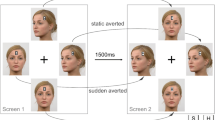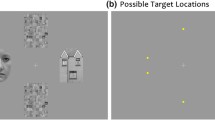Abstract
Three experiments using computer-generated human figures showed that after a prolonged observation of eyes looking to the left (or right), eyes looking directly toward the viewer appeared directed to the right (or left). Observation of an arrow pointing left or right did not induce this aftereffect on the perceived eye direction. Happy faces produced the aftereffect more effectively than surprised faces, even though the image features of the eyes were identical for both the happy and the surprised faces. These results suggest that the eye direction aftereffect may reflect the adaptation of relatively higher-level mechanisms analyzing the other’s eye direction.




Similar content being viewed by others
References
Ando, S. (2002). Luminance-induced shift in the apparent direction of gaze. Perception, 31, 657–674.
Baron-Cohen, S. (1995a). The eye direction detector (EDD) and the shared attention mechanism (SAM): Two cases for evolutionary psychology. In C. Moor & P. J. Dunham (Eds.), Joint attention: its origins and role in development (pp. 41–59). Hillsdale, NJ: Erlbaum.
Baron-Cohen, S. (1995b). Mindblindness: An essay on autism and theory of mind. Cambridge, MA: MIT.
Baron-Cohen, S., & Cross, P. (1992). Reading the eyes: Evidence for the role of perception in the development of a theory of mind. Mind & Language, 7, 172–186.
Coltheart, M. (1971). Visual feature-analyzers and aftereffects of tilt and curvature. Psychological Review, 78, 114–121.
Downing, P. E., Dodds, C. M., & Bray, D. (2004). Why does the gaze of others direct visual attention? Visual Cognition, 11, 71–79.
Driver, J., Davis, G., Ricciardelli, P., Kidd, P., Maxwell, E., & Baron-Cohen, S. (1999). Gaze perception triggers reflexive visuospatial orienting. Visual Cognition, 6, 509–540.
Eastwood, J. D., Smilek, D., & Merikle, P. M. (2001). Differential attentional guidance by unattended faces expressing positive and negative emotion. Perception & Psychophysics, 63, 1004–1013.
Emery, N. J. (2000). The eyes have it: The neuroethology, function and evolution of social gaze. Neuroscience and Biobehavioral Reviews, 24, 581–604.
Friesen, C. K., & Kingstone, A. (1998). The eyes have it! Reflexive orienting is triggered by nonpredictive gaze. Psychonomic Bulletin & Review, 5, 490–495.
Frisby, J. (1979). Seeing. Oxford: Oxford University Press.
Hietanen, J. K. (1999). Does your gaze direction and head orientation shift my visual attention? Neuroreport, 10, 3443–3447.
Hietanen, J. K. (2002). Social attention orienting integrates visual information from head and body orientation. Psychological Research/Psychologische Forschung, 66, 174–179.
Hietanen, J. K., & Leppänen, J. M. (2003). Does facial expression affect attention orienting by gaze direction cues? Journal of Experimental Psychology: Human Perception and Performance, 29, 1228–1243.
Hikosaka, O., Miyauchi, S., & Shimojo, S. (1993). Focal visual attention produces illusory temporal order and motion sensation. Vision Research, 33, 1219–1240.
Hooker, C. I., Paller, K. A., Gitelman, D. R., Parrish, T. B., Mesulam, M.-M., & Reber, P. J. (2003). Brain networks for analyzing eye gaze. Cognitive Brain Research, 17, 406–418.
Jenkins, J., & Langton, S. R. H. (2003). Configural processing in the perception of eye-gaze direction. Perception, 32, 1181–1188.
Kitazaki, M., & Sato, T. (2003). Attentional modulation of self-motion perception. Perception, 32, 475–484.
Köhler, W., & Emery, D. A. (1947). Figural after-effects in the third dimension of visual space. American Journal of Psychology, 60, 159–201.
Langton, S. R. H. (2000). The mutual influence of gaze and head orientation in the analysis of social attention direction. Quarterly Journal of Experimental Psychology, 53A, 825–845.
Langton, S. R. H., & Bruce, V. (1999). Reflexive visual orienting in response to the social attention of others. Visual Cognition, 6, 541–567.
Langton, S. R. H., Watt, R. J., & Bruce, V. (2000). Do the eyes have it? Cues to the direction of social attention. Trends in Cognitive Sciences, 4, 50–59.
Leopold, D. A., O’Toole, A. J., Vetter, T., & Blanz, V. (2001). Prototype-referenced shape encoding revealed by high-level aftereffects. Nature Neuroscience, 4, 89–94.
Mathews, A., Fox, E., Yiend, J., & Calder, A. (2003). The face of fear: Effects of eye gaze and emotion on visual attention. Visual Cognition, 10, 823–835.
Öhman, A., Lundqvist, D., & Esteves, F. (2001). The face in the crowd revisited: A threat advantage with schematic stimuli. Journal of Personality and Social Psychology, 80, 381–396.
O’Leary, A., & McMahon, M. (1991). Adaptation to form distortion of a familiar shape. Perception & Psychophysics, 49, 328–332.
Perrett, D. I., & Emery, N. J. (1994). Understanding the intentions of others from visual signals: Neurophysiological evidence. Cahiers de Psychologie Cognitive, 13, 683–694.
Perrett, D. I., Hietanen, J. K., Oram, M. W., & Benson, P. J. (1992). Organization and functions of cells responsive to faces in the temporal cortex. Philosophical Transactions of the Royal Society of London, Series B, 335, 23–30.
Rhodes, G., Jeffery, L., Watson, T. L., Clifford, C. W. G., & Nakayama, K. (2003). Fitting the mind to the world: Face adaptation and attractiveness aftereffects. Psychological Science, 14, 558–566.
Ricciardelli, P., Baylis, G., & Driver, J. (2000). The positive and negative of human expertise in gaze perception. Cognition, 77, B1–B14.
Ristic, J., Friesen, C. K., & Kingstone, A. (2002). Are eyes special? It depends on how you look at it. Psychonomic Bulletin & Review, 9, 507–513.
Seyama, J., & Nagayama, R. S. (2002). Perceived eye size is larger in happy faces than in surprised faces. Perception, 31, 1153–1155.
Seyama, J., & Nagayama, R. S. (in press). The effect of torso direction on the judgment of eye direction. Visual Cognition.
Sinha, P. (2000). Here’s looking at you, kid. Perception, 29, 1005–1008.
Spivey, M. J., & Spirn, M. J. (2000). Selective visual attention modulates the direct tilt aftereffect. Perception & Psychophysics, 62, 1525–1533.
Tomonaga, M., Kumada, T., & Yoshikawa, S. (2002). Visual cognition from the standpoint of comparative cognitive science. Japanese Journal of Psychonomic Science, 20, 193–208.
Troje, N. F., & Siebeck, U. (1998). Illumination-induced apparent shift in orientation of human heads. Perception, 27, 671–680.
Valentine, T. (1991). A unified account of the effects of distinctiveness, inversion, and race in face recognition. Quarterly Journal of Experimental Psychology, 43A, 161–204.
von Grünau, M., & Anston, C. (1995). The detection of gaze direction: A state-in-the-crowd effect. Perception, 24, 1297–1313.
Vuilleumier, P. (2002). Facial expression and selective attention. Current Opinion In Psychiatry, 15, 291–300.
Watson, T. L., & Clifford, C. W. G. (2003). Pulling faces: An investigation of the face-distortion aftereffect. Perception, 32, 1109–1116.
Webster, M. A., & MacLin, O. H. (1999). Figural aftereffects in the perception of faces. Psychonomic Bulletin & Review, 6, 647–653.
Webster, M. A., Kaping, D., Mizokami, Y., & Duhamel, P. (2004). Adaptation to natural facial categories. Nature, 428, 557–561.
Wichmann, F. A., & Hill, N. J. (2001). The psychometric function. I. Fitting, sampling, and goodness of fit. Perception & Psychophysics, 63, 1293–1313.
Zhao, L., & Chubb, C. (2001). The size-tuning of the face-distortion after-effect. Vision Research, 41, 2979–2994.
Zorzi, M., Mapelli, D., Rusconi, E., & Umiltà, C. (2003). Automatic spatial coding of perceived gaze direction is revealed by the Simon effect. Psychonomic Bulletin & Review, 10, 423–429.
Acknowledgements
This work was supported by MEXT.KAKENHI (14710039). The authors thank two anonymous reviewers for their helpful comments and suggestions.
Author information
Authors and Affiliations
Corresponding author
Rights and permissions
About this article
Cite this article
Seyama, J., Nagayama, R.S. Eye direction aftereffect. Psychological Research 70, 59–67 (2006). https://doi.org/10.1007/s00426-004-0188-3
Received:
Accepted:
Published:
Issue Date:
DOI: https://doi.org/10.1007/s00426-004-0188-3




